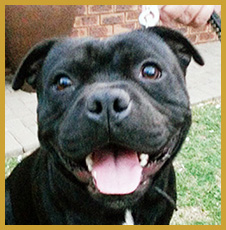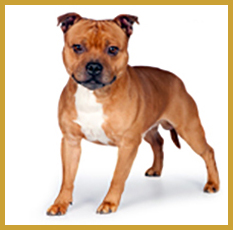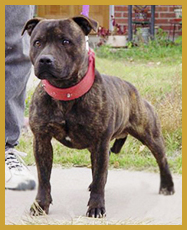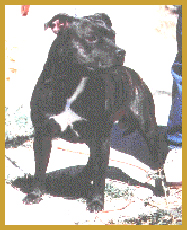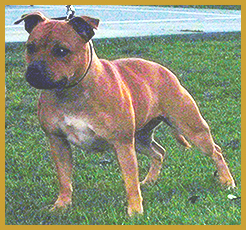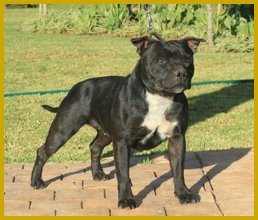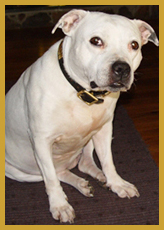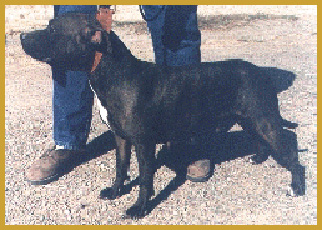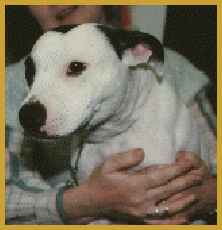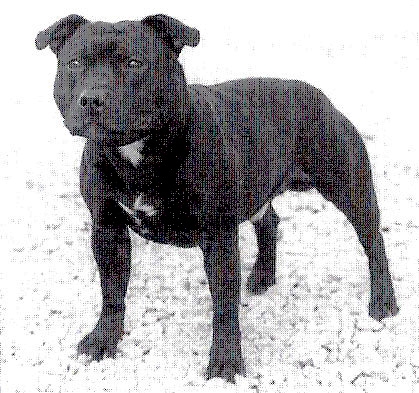The road to H... is paved with good intentions!
During Fall, 1998, Craig Harrington and I exchanged several private email messages relating to concerns for the welfare of the Breed based on his observations in the AKC show ring. I pointed out that U.S. Staffords constitute at most a splinter group of Staffords from a world-wide perspective and that in all countries, even England, perhaps only two percent of all Staffords whelped ever see the inside of a show ring . In England the vast majority of typical, sound, and healthy Staffords stay at home with their masters -- In other words, what he was seeing in the AKC show ring was definitely an atypical picture of the world's approximately 150,000 living Staffords. During my December, 1998, trip to Australia, Aussie Stafford fancier and author Glenn Consadine provided me with a copy of the 1997 Stafford Annual (England) in which I found statistical evidence to support my claim.. I sent it to Craig who, after perusing it thoroughly, responded with an email message addressed not only to me but to several other Staffanatics who shared our interests. The following is an edited digest of the cyber-colloquy that followed.
Steve Stone
CRAIG HARRINGTON:
...In this Breed, and in many others, its most vocal proponents seem to be those involved in the conformation show fancy... What interests me is that in England, where Stafford registrations top 8,000 pups per year, although many go unregistered, very few CC winners come from any but five or six significant kennels. At least that is my observation from the 45 CC winners pictured in the 1997 Annual. Even more interesting is that at least 22 out of 45 CC winners has an Eastaff dog in the pedigree.
Six or so years ago when I was "bugging" anyone with questions on Staffords, Joyce Shorrocks of the Eastaff prefix was one of the few who took the time and had the patience to pen me some answers and send some nice pictures, so I have nothing but good thoughts about her personally. But 22 out of 45 CC winners in '97 have her kennel name in a three or four generation pedigree, -- probably more, but I don't have a database.
Although I have to make some assumptions the following are my observations:
- In general, the Staffords shown in the UK come from a very small "pocket" of dogs. If you eliminated five or six key dogs from the 45 CC winners you would have only a couple of winners still standing.
- This small pocket of show-winning Staffords is controlled by an equally small group of fanciers, if you look at the total number of Staffords registered, co-ownerships, breeding contracts, etc.
- This comparatively small group of fanciers essentially provide the only forums for learning and discussion on the breed through the fruits of the show game, publications/literature and notoriety within the breed.
- If this small group of fanciers does not hold the highest standards in breeding Staffords, the breed may be due for trouble....
- When a newcomer to the breed seeks information on the breed he or she will generally encounter information produced by this small but vocal pocket of the Fancy. One might say that at least this small group of fanciers is promoting the breed, but that would be cynical.
Following are some other observations posted to several other folks on December 30, 1998:
- As regards show dogs, the UK is far ahead of us. (duh)
- A statistically insignificant number of Staffords in the UK have had their eyes tested. One day it will be discovered that a very popular stud dog suffered from the problem, at which time some breeders will claim that, like deafness in Bull Terriers, cataracts have to be considered "just one of those things you have to put up with."
- In each of the three years that statistics covered, it appears a smaller number of stud dogs produced a larger percentage of registered pups.
- Average litter size ranged from a low of 2.66 (Sir Winston Morey) by these much-used stud dogs to a high of seven pups per litter (CH Valglo Lancer).
- The average litter size of these much-used stud dogs (six or more litters per year) was 4.5 pups per litter.
- For example, Ch Bellglen Rich Desier of Rikamia had an average litter size of 3.76 in 1995 while siring 13 litters. In 1996 , however, he sired 16 litters with an average litter size of 5. (I think that many breeders do not register all pups in a litter. I would suspect that either mortality or defects cause some breeders to report smaller numbers. This is pragmatic but misleading. There seems little point in registering a dead or defective puppy, but if you don't then the statistics become skewed.
- Very few UK champions are whelped by Champion dams although most UK Champions are sired by Champion dogs. Probably just a few breeders/kennels are in the dog show game, and these folks may be in such a rush to make up a new dog Champion that they do not accord the same opportunity to bitches, thereby ignoring or downplaying, quite wrongly, the importance of the bitch. I'm probably over-reacting here, but there is no good reason in eliminating or reducing exposure of the bitch in showing, except that it is possible to have a problem with an older maiden bitch during whelping.
- Omitted is any mention of Staffords used in a utility role except for one serving as a therapy dog in a nursing home, a noble occupation but hardly a job which hallmarks the many facets of the breed.
- Question: Where are the useful Staffords? Are we to assume that more than 90% of Staffords not participating in show business but serve only as family pets?
STEVE STONE:
Craig, you've come to precisely the conclusions I believed you would... which means that you are beginning see the true nature of the Staffordshire Bull Terrier world beyond the visible facade of the show ring. Not that I have anything against the show ring itself, for shows are the only legitimate way that purebred dogs can be promoted in society as it is now constituted. Although not a exhibitor myself, I founded the SBTC/USA specifically to get the Breed into the AKC.
However, if any Stafford is nothing more than a show dog, no matter how successful its career, it's not even worth feeding, and in perfect candor I must say that I've never seen such a creature and hope I never will.
The Stafford was, is, and must continue to be the "foremost all-purpose dog." In England, South Africa, and Australia, the majority of veteran Stafford exhibitors realize this, but in America I'm afraid that all too few see the light.
I knew you'd read those the stats right...
CRAIG HARRINGTON:
The stats speak for themselves except that if the English show folks are not damned careful about their breeding-stock's genetic health, they may damage the breed seriously.
When a dog is bred to bitches that whelp 29 times in two years, he inevitably exerts great Breed influence in just a couple of years.
Most genetic disease affecting the Breed are probably complex recessives. Low registration figures in some lines seems unrelated to excessive inbreeding as most breeders do not inbreed to that degree.
Immune deficiency syndrome associated with demodectic mange seems to be one of those issues that those "in the know" have decreed a non-issue -- which is nothing but plain old "bull."
PAUL SKELTON:
According to my own research, the US situation seems much the same, short-sighted and frightening. I'd exchange four Champion stud dogs for one Champion bitch, utility or conformation. The conformation show promotes dogs because that is where the standards come from, but bitches are more definitive of what the puppies will be like.
JOHN THOMPSON:
I think Craig partially picked up on something. He mentioned dogs sharing common ancestors as winning big in English shows. Now the trick is to look at the judges who have awarded C.C.'s to them, which information also appears in the Annual. Over the past three years or so, not only do they share the same dogs in the lines, but judging appointments are awarded according to how they judge.
This happens when boards are run by cliques and the Breed Standard is held in abeyance. Some say that if you do not like this practice, you should not show under those judges --- but the English show system differs sharply from that in the U.S.
On any given weekend in the U.K., there is only one championship show on the weekend, so the newcomer has no option unless he waits until the next weekend.
JUANITA HOBBS:
Craig is right to bring up the connection about the number of times that Eastaff dogs appears in the 1997 CC winners' pedigrees although not all Eastaffs are related.
I have a smallish database of about 8,000 Staffords and, using this still incomplete tool... It seems that the most notable dogs NOT included in the list of Black Tusker descendants are Ch (Eng) Jokartan Royal Tan , Ch (Eng) Swinfen Skyscraper, Ch(Eng) Kaluki Duke, Ch (Eng) Teutonic Warrior, Ch (Eng) Wallace The Wizard, Ch( SA) & Ch (Eng) Belnite Dark Huntsman, the Ashstock dogs, and the Dennybeck dogs.
Ch (SA) Magliam The Bronx Bull and his brothers Ch (Eng) Redstaff King and Ch (Eng) The Malaser Mauler.
This means that there are plenty of dogs around that are NOT descended from Black Tusker!
In South Africa, we have only some 14 registered dogs NOT descended from Ch (SA) Magliam The Bronx Bull of Tenacious (UK Imp) and that are being, or will be, actively used in breeding or showing.
Considering that the largest exporters to other countries are England and South Africa, I suspect that, in time, all registered stock in the world will be descended from Black Tusker.
Please do not misread my intention, for I have nothing against Black Tusker himself, but I think the point is made.
Black Tusker's Influence In The Show Ring
If you look at three years of Champions in England (1995, 1996 and 1997) you will see the following:
1995
There were 18 Champions made up in England. A total of 11 were descended from Black Tusker and 7 were not. Those 7 are:
- Ch Hazestaff Kegra Red Amber (bitch)
- Ch Jodel's Box of Delights (bitch)
- Ch Kenine Deva-Anvil of Ambesten (dog)
- Ch Bellglen Rich Desire of Rikamia (dog)
- Ch Highland Pied Piper (bitch);
- Ch Nordic Chief (dog)
- Ch Bellglen Braws Best (bitch))
1996
There were 12 Champions made up in England. All 12 were descended from Black Tusker.
1997
There were 10 Champions made up in England. A total of 9 were descended from Black Tusker and only 1 was not (Ch Highland Dream [dog]).
Influence On The English Stud Dogs
1994
There were 19 dogs that sired 6 or more litters. Of those 8 (42%) were descended from Black Tusker.
1995
There wee 27 dogs that sired 6 or more litters. Of those 12 (44%) were descended from Black Tusker.
1996
There were 33 dogs that sired 6 or more litters. Of those 14 (42%) were descended from Black Tusker.
Stud Dogs Who Have Sired Three Or More Champions
- 1st is Black Tusker with 16 Champion progeny.
- 3rd (joint) is Ch Constones Yer Man with 10 Ch progeny. He is a SON of Black Tusker.
- 5th (joint) is Ch Hurricane of Judael with 7 Ch progeny. Hurricane's paternal grandfather is Black King 1, who is the sire of Black Tusker. Additionally, both Hurricane and Black Tusker are inbred to Rumbuster.
- 6th (joint) is Ch Skean Dhu with 5 Ch progeny. Skean Dhu is a SON of Black Tusker.
- 7th (joint) is Wyrefare Billy Ruffian with 4 Ch progeny. Billy Ruffian is a great-great-grandson of Black Tusker.
Jackstaff Rustic Prince with 4 Ch progeny. Rustic Prince is a great-great-great-great grandson of Black Tusker.
Tondoo Tallyman with 4 Ch progeny. Tallyman is a grandson of Black Tusker.
- 8th (joint) Ch Rendorn Drummer Boy of Kazemick with 3 Ch progeny. Drummer Boy is a grandson of Black Tusker.
Eastaff Tally's Man with 3 Ch progeny. Tally's Man is a grandson of Black Tusker.
Influence On The English Brood Bitches
(unfortunately, there is very little information available on the brood bitches)
- 2nd (joint) is Ch Jackstaff Heaven Sent with 3 Ch progeny. She is a great-great granddaughter of Black Tusker.
Devil's Brew of Eastaff with 3 Ch progeny. She is a granddaughter of Black Tusker.
Black Tusker's Pedigree
Born 8 October 1975
Owner: B Bates & M Boam
Breeder: G Cowdell
Became a Champion in 1978
Won 14 CC's
English Champions Descended From UK Ch Black Tusker (known):
| First generation (16 - - - 10 sons & 6 daughters): |
| Ch Skean Dhu (dog) Ch Ginnels Black Tuskyanna (dog) Ch Karjobri Black Pepper (dog) Ch Earlsdon Viceroy of Benfirth dog) Ch Rendorn Devil's Timpani (bitch) Ch Bobstaffs Grand King of Durward (dog) Ch Lydes Cleopatra (bitch) Ch Rowenda Devil's Desciple (dog) Ch Lydes Hermione (bitch) Ch Eastaff Guardian (dog) Ch Topcroft Trailblazer (bitch) Ch Fulfin Black Eagle (dog) Ch Devil's Trill (bitch) Ch Eastaff Ironsides (dog) Ch Surestaff Aphrodite (bitch) Ch Constones Yer Man (dog) |
| Second generation (grandchildren): |
| Ch Solo Gypsy Fiddler (bitch) Ch Spadille Spare The Rod (bitch) Ch Carndearg Jake The Rake (dog) Ch Allendale King (dog) Ch Belle Hurricane Duchess (bitch) Ch Tondo Miss Moon Shine (bitch) Ch Rendorn Drummer Boy of Kazemick (dog) Ch Spartan Victor (dog) Ch Rowenda Fearless Lad (dog) Ch Rendorn Apollyon (bitch) Ch Rockys Black Sea-Eagle (dog) Ch Scarthwaite Diplomat (dog) Ch Rellim Black Ace (dog) Ch Rellim Task Force of Nozac (dog) Ch Ebony Dreadnought (dog) Ch Tikkurilan Giddy Kipper (bitch) Ch Takiron Dark Destroyer (dog) Ch Midnight Huntress (bitch) Ch Kablice Midnight Caller (dog) Ch Zabaretts Razzle Dazzle (bitch) Ch Ensbury's Little Lad at Shirestaff (dog) Ch Hot Pursuit (dog) Ch Rowenda Dark Destroyer (dog) Ch Stormstaff Sky's The Limit (bitch) Ch Mary Queen of Staffs at Vulcanstaff (bitch) Ch Scarthwaite Bewitched (bitch) Ch Edgestaff Tammy Girl (bitch) Ch Jackbull Jeffs Pal (dog) |
| Third generation or more: |
| Ch Karjobri Pure Silk (bitch) Ch Rendorn Right Marker (bitch) Ch Jackstaff Heaven Sent (bitch) Ch Jackstaff Primadonna (bitch) Ch Skerry Dhu of Dumbriton (dog) Ch Rendorn The Renegade of Linestaff (dog) Ch Coal Queen (bitch) Ch Eastaff Noire-Fille (bitch) Ch Grange Spitfire (bitch) Ch Judael Vestajay of Linestaff (bitch) Ch Spartan Wild Thyme (bitch) Ch Chewbacca The Wookie (dog) Ch Eastaff Lil' Stotter (dog) Ch Langrove Maltster (dog) Ch Jackstaff Forget Me Not (bitch) Ch Makeready Huntsman's Lass (bitch) Ch Waystaff Bold As Brass (bitch) Ch Lethal Weapon of Crashkon (dog) Ch Bated Breath at Constones (bitch) Ch Fromestaff Nettle of Wyrefare (bitch) Ch Indiana Jet Setter (bitch) Ch Jackstaff Fatal Attraction (bitch) Ch Judael Magie Noire (bitch) Ch Parkstaff Special Envoy at Jackstaff (bitch) Ch Judael Masquerade (bitch) Ch White of Morn (bitch) Ch Boldbull Black Jack (dog) Ch Debrella Taboo Dhu at Dumbriton (bitch) Ch Sher Khan (dog) Ch Pantycelyn Hagler (dog) Ch Boldmore Finbar Furey (dog) Ch Fromestaff Abracadabra of Wyrefare (bitch) Ch Sparstaff Dominator (dog) Ch Staffmaster Pure Opium (bitch) Ch Quarterflash Warsquaw (bitch) Ch Eastar Ultimate Warrior (dog) Ch Kool As Ice (bitch) Ch Judael Dark Reality of Cavstaff (bitch) Ch Crashkon High Society of Broadway (bitch) Ch Barda The Bushranger (dog) Ch Valglo Corolla (bitch) Ch Look Me Over (bitch) Ch Dogan Lily Bianca (bitch) Ch Judael Both Barrels at Nozac (dog) Ch Crossguns Revolution (dog) Ch Debrella Scotch On The Rocks of Dumbriton (dog) Ch Eastaff Trefoil (bitch) Ch Fromestaff The Minstrel (dog) Ch Crossguns Saturday Special at Berlscarg (bitch) Ch Beaconmoor Christmas Star (bitch) Ch Nethertonian Rose (bitch) Ch Szondu Ulster Maddy (bitch) Ch Bullyview Alright Mate (dog) Ch Belsevore Ross-N-Co (dog) Ch Bombstaff Blackthorn at Bullhawk (dog) Ch Ramblix Renaissance (bitch) Ch The Slingshot Electraglide (bitch) Ch Blistaff Mad O'Rourke (dog) Ch Timgold Rita The Raver (bitch) Ch Donnellas Get Up And Go (bitch) Ch Stormlodge Anne Bonny (bitch) Ch Jamarvins Femme Fatal of Vanoric (bitch) Ch Chelmstaff Christmas Joy at Ramshire (bitch) Ch Brystaff Mindern Rose at Obmarstaff (bitch) Ch Brystaff Simply The Best (dog) Ch Valglo Lancer (dog) Ch Canny Bairn for Jayneze (bitch) Ch Seren's Baby Lleuad of Dogan (bitch) Ch Jagsstaff Black Belize (dog) Ch Spirestaff Avenging Angel of Tikkurilan (bitch) Ch Ryestaff Ebony Eyes (bitch) |
I believe that all this IS pointing towards a converging circle, genetically speaking. England is on the verge of getting completely tied into Black Tusker - as we in South Africa have got almost completely tied into The Bronx Bull.
Even though the Black Tusker descendants only account for just over 40% of the most popular stud dogs, we have no way of telling how many Black Tusker bitches are being put to the other non-Tusker popular stud dogs. It could be most of them, it might be none.
Do I personally have an axe to grind against Black Tusker? No.
Is my stock descended from Black Tusker? Yes, all of it. My foundation bitch is a doubled-up great-great-great-great granddaughter of his through Ch (Eng) Skean Dhu twice. My English imported male is bred back to him on the 5th, 6th and 7th generations and he appears 7 times altogether on that pedigree.
PAUL SKELTON:
From the general gist of things, and considering that I probably have the highest concentration of Black Tusker blood here as the great-great grandsire on both sides of my stock, do I fix them both now or wait until they finished their show careers? Do I not enter their genes into the gene pool of US Staffords, even though many dogs I seen having less or no Black Tusker blood tend to be (IMHO) a long way from the standard?
Linda can input her perspective on my dog with more objectivity than I can, but from what I have seen, I think he has qualities sorely lacking in many winning AKC dogs.
In my opinion, if we do not follow a sound breeding program, concentrating qualities that we want to remain in the Breed ,while culling offspring lacking these qualities, we are then devastating the Breed.
Eliminating or including any dog from breeding ... is as short-sighted as breeding to a top winning dog that has virtually none of the qualities or standards that the breed is known for.
LINDA BARKER:
By no means (in my often NSHO) should an animal be removed from a breeding program based upon bloodlines, unless it can be proven BEYOND a shadow of a doubt that it carries and passes on genetic flaws detrimental to the Breed.
What the discussion points out is that you can get such a concentration of genes in the pool that you begin finding flaws, genetic or structural, that are detrimental to the animals.
As I have mentioned, King is flush-mouthed. He and his sister are the first bad mouths I've bred since a litter born in 1982. Now, for those of you who do not know King's pedigree, his sire and dam are 1/2 brother and sister; the dam of both being Ch. Barkers Bulwatch Ohmygosh. King's dam is a father-to-daughter product (in-breeding), while King's sire is a linebred dog. Does this mean that I will never allow King to be used at stud? No. Does it mean I will not breed from his sister that I co-own? No. I will just be very careful about the mouths behind the animals to which they are bred.
One of my four Staffords is outside the standard, size-wise at 17" inches and 45 pounds at just under a year. That wouldn't stop me from using him at stud over the right bitch. What will stop him from being used is that I feel he has a tight front, upright shoulders, straight stifles in addition to being too big.
MAGNUS PALSSON:
Why all the hoopla about Black Tusker? No one is forced to use any of his descendants for breeding. If his offspring do all the winning at the shows, and that's what you want, then go ahead and use them.
But be prepared to pay the price later on.
The stats presented by Craig and Juanita makes scary reading, but what scares me even more is that some breeders seemingly can't see the obvious solution: stop using those dogs at stud. Doing so might cost a couple of generations without big show-wins, but you'll be doing the Breed a big favor.
And isn't our love for the Breed the thing that really matters?
Plenty of other "typy" dogs can be used at stud. Joe Mallen won't step down from Stafford Heaven to punish you for breeding from "obscure" dogs!
This "alarming" situation shouldn't come as news. Ever since shows became a real force in the world of dogs and breeders started to breed strictly for conformation, every breed affiliated with such activity has experienced a DECLINE in true quality because breeders lose perspective, forget about their duties to the breed, and start using nothing but "show winners" at stud. Thus, the biggest winner becomes bred from too many times, whereas the unknown dogs spent their lives without (much breeding opportunity).
In the old days, Stafford breeders were more concerned with their own strains. Thus, a pitwinner from Newcastle would surely sire lots of pups in that particular area, but, due to other breeders' jealously guarded "blood" (and due to lack of rapid transportation), he probably wouldn't sire a single pup in, say, Walsall. And the Walsall gents would surely be uninterested in that Newcastle dog's offspring! ("We've got better dogs here!")
So, unintentionally, breeders actually stopped any dog from exerting undue influence to the entire Breed. Today, we import dogs from all over, cross them with our own strains, and thereby slowly shut off our escape route: outcrossing via unrelated strains.
Further, shows don't necessarily promote well-constructed, sound, and healthy dogs. When you show off your pride and joy to 40 renowned judges, they give you THEIR opinion as to how well your dog compares to THEIR ideal (sometimes based on the Standard, sometimes not), and nothing else. Some adventurous judges will even add comments such as "sound mover," but what does that say, really? Do these judges really know about vigorous activities? Don't you know your own dog better than any judge ever could?
I've seen dogs with truly lousy movements win at dog shows, and I know of at least two dysplastic Staffords that were big winners. This should tell you something about dog shows and the quality needed to become a winner. As long as the exhibit LOOKS GOOD , no one questions its true quality. And some owners seemingly stop using their own eyes and common sense, breeding from this or that "specimen" simply because some judges claim that the dog is beautiful, typy, and showed "sound movement."
Inbreeding from extremely healthy animals is risky enough, but inbreeding from anything less than extremely healthy animals spells disaster...
Are big show winners actually worth inbreeding from? If your answer is "yes", I'd like to hear the reasons (and DON'T send me their show record). If your answer is "no", I'd like to hear if you've got some of this tight blood in your own stock, and your basis for having it.
Fighting certainly calls for superbly constructed dogs because both the combat and the "keep" is hard work,. We can rest assured that the old-time dogs were healthier in EVERY respect than our present Staffords due to this activity. Can you imagine a dog with a defective immune system surviving a battle? No, and neither can you imagine a dysplastic dog or one with respiratory problems winning a fight. Thus, fighting tended to weed out the unfit dogs, and this, in turn, meant that the gene pool enjoyed excellent quality, health-wise.
Not so today, when an increasingly limited gene pool suffers from many defects. We've stopped culling the inferior ones ("I know nothing about this dog's joints, or his respiratory system, but he did win the BlablaSBT club's annual Specialty Show, so I gotta use him at stud like everybody else is doing!"), and we're slowly beginning to realize the results from it.
The Fancy has asked for this situation, and we have no one to blame but ourselves.
One of Sweden's most famous geneticists said: "The broadest standards are the only ones which will work over a long period of time if you've got your breed's welfare in mind." On dog shows, he said: "Dog shows are a nice pastime for pet owners, but no one can ever breed dogs for show while still claiming any seriousness whatsoever."
I could quote him on other matters, but let me sum it up for you: A little less narrow view on what constitutes a typy dog will work wonders for the genepool...... That is, don't limit your choice of stud to the "famous" ones. Make sure the ones you use are healthy and mentally sound. As I said, you might have to bide your time waiting for that big winner when you breed from "unknown" dogs, but it should be worth the wait.
Thank God for backyard breeders! The ones who never heard of Black Tusker, the ones who'll breed their not-so-fabulous bitch to the neighbor's not-so-fabulous dog. They are -- unintentionally of course, -- preserving the breed's gene pool. Can you imagine the day when the "top breeders" ask Mr Nobody for the use of his scruffy-looking "stud" since their own stock is too crippled from different hereditary diseases thanks to injudicious use of inbreeding? That would be beautifully ironic!
This, I believe, will happen some day, and that's why I, myself, refuse to "jump on the train." I'm perfectly happy with my own "ugly" dogs, and I honestly believe that I'm doing the Breed a favor by breeding from those "nondescript" dogs. I try to keep my own strain going, and, some day, someone will certainly find it a necessary outcross.
Want to make sure you've got an escape route? Create your own inbred strain. Never mind about showpoints......let the fancy ones pop up where they may. Your duty is NOT to breed show winners, your duty is to preserve what our forebears saved for us.
LINDA BARKER:
About hereditary diseases in the stafford; I have come across the following, in the breed:
HD and, since the number of dogs in this country being x-rayed is increasing, I think we will begin to see the percentage drop.
Juvenile cataracts, this has turned up in the breed in this country; since there is no DNA test for this in our breed, there is no way to trace it.
Progressive retinal atrophy; to the best of my knowledge, only one stafford has ever been diagnosed with this. That was my old stud dog, J.R. He was diagnosed by a CERF Vet, and since he was 9 years of age, had already sired all the pups he was going to. I took him to the UT Vet Hospital (as well as the progeny of his that I had in the house at the time) and had them all ERGed (electro-retina-graph), none of his progeny showed any signs of the disease. an inbred daughter of his was tested at UAr the same way and she showed no signs of the disease. In talking to the Vets at UT, we came to the following conclusion; J.R. had a PRA appearing condition. This conclusion was reached due to the following reasons; J.R.'s PRA was asymmetrical, and he had been hit by a car at 18 mos. of age and the eye affected worse was the one away from the side of his head that the car hit. The Vet felt that this was probably the reason for the condition. By the way, none of the staffords down from J.R. has ever shown any signs of PRA.
I count straight stifles, upright shoulders, bad ears, bad mouths, bad toplines, etc, as structural faults that can be corrected with breeding. While they are passed on genetically, they are not detrimental to the animal's being able to exist in society comfortably.
JOHN THOMPSON:
Opinions differ on what a Stafford should look like.
There is a man in the U.K. which has been involved with Staffords for over 40 years. He's a Ch. show judge, occasional breeder, and a good Stafford man.
He bred a bitch that stands 18 inches and around 40 pounds. She was put to a 16 inch dog out of his breeding and a good litter may be on the ground soon.
His dogs can do all the Standard describes and then some. They are based on Rapparee lines with little if any Tusker at all.
There is a dog called Black King in the pedigrees of many Rapparee dogs, a different Black King altogether from the one that is Black Tusker's sire.
MAGNUS PALSSON:
Great to hear! This is what I'm talking about. My spirits are raised every time I find this sort of stuff, and it's very typical that the man who's "guilty" of this type of breeding is an old-timer.
I suppose you mean the ORIGINAL Black King by Somerville Black Bomber x It's a Pal. Very definitely a different dog from Tusker's sire.
JUANITA HOBBS:
The Ch (Eng) Black Tusker we've been discussing was owned by Malcolm Boam in partnership with Bates. Its sire was the SECOND Black King by Rumbuster ex Bellerophon Wonder Girl.
Strange but true: Malcolm Boam's first show champion was Ch (Eng) The Black Monarch (born in 1959) who was sired by the original Black King (breeding as given by Magnus).
Further incidental information: The Black Monarch's dam was Atoms Choice who, like the original Black King, was closely bred back to Brindle Mick. From what I can trace on my incomplete database, Brindle Mick appears 34 times in The Black Monarch's pedigree - 20 on the sire's side and 14 on the dam's side.
STEVE STONE
I was fortune enough to see The Black Monarch in the flesh and to import two of his daughters into Finland where one became the foundation of Finland's most successful kennel. He's an all-time favorite of mine..
My earlier concern with M-Line stock stemmed from the fact that the M-Line has come to dominate the Breed and consequently most of the hereditary diseases we're concerned about are found in the M-Line. Nevertheless, there are still plenty of good, sound, typy M-Line dogs in existence, perfectly good for breeding programs.
Even so, most M-Line dogs trace directly back to Brindle Mick in EVERY (male) line, and although it's not strictly correct to us the term almost every bitch in the pedigree is an M-Line bitch. This does NOT necessarily spell t - r - o - u - b - e today, but it should serve as a warning, for it inevitably means trouble within two decades unless breeders world-wide suddenly "get religion" and begin to breed AND cull more with infinitely more care than they have until now. Realistically, one can hardly expect this to happen.
Now Juanita has brought it to our attention that a much more recent specimen, Black Tusker, has come to appear in the pedigrees of the great majority of winning show dogs in all major Stafford countries -- to a degree that is somewhat alarming, primarily because Black Tusker is so recent. Now for a few thoughts specifically on this dog and what he means to us all:
a) Black Tusker was a superb specimen and prepotent sire as his record indicates. He obviously brought some outstanding qualities to the Breed, and for that we must be grateful.
b) Some of Black Tusker's descendants may have spread hereditary defects in the Breed, but I'll wager that if we check the record we'll find that such cases result from unwise intensive inbreeding between Black Tusker descendants, coupled with a total lack of culling, so the blame -- if any is to be allotted -- cannot be laid at the doorstep of Black Tusker himself or his breeder or even of his inbred descendants -- but rather at the doorstep of the foolish folk who practiced inbreeding among Black Tusker's descendants without ruthlessly culling the unfit.
c) If there is any danger connected with the appearance of Black Tusker in so many winning pedigrees, it would be cases in which Black Tusker appears often, occasionally seven or eight times, in a three-generation pedigree. Even in these cases, no "clear and present danger" exists (unless afflicted offspring crop up) but certainly the potential for trouble is there. But for the most part, that peril can be avoided by judicious outcrossing and/or linebreeding coupled with draconian culling.
d) Use of the terms "R-Line" and "M-Line" is neither modern nor scientific and cannot serve as legitimate genetic descriptions. Rather, today they can and do serve a kind of book-keeping function whereby we can keep track of how many red beans are in the red pile and how many brown beans are in the brown pile.
e) To the best of my knowledge, modern R-Line Staffords descend exclusively from Ch. Bandits Brintiga who covered not only a variety of bitches from the R-Line and J-Line but mostly bitches from the M-Line.
f) M-Line Staffords probably outnumber R-Line Staffords fifty to one (or more), but oddly enough the smallish population of R-Line Staffords constitutes one of its greatest strengths: nobody can possibly keep track of the world's M-Line Staffords and their breeding, the numbers being so huge, but it is quite possible to keep track of the world's important R-Line Staffords and their breeding. Being a minority, R-Line breeders have not only the means to work together cooperatively but the incentive.
g) "Working together cooperatively" means nothing more or less than helping each other to maintain and improve a separate genetic strain of Stafford against the not-too-distant day when M-Line problems become even more severe and virtually universal. It does NOT mean being or acting anti-M-Line in any way. In fact, it means quite the opposite: being in a position to HELP M-Line breeders when the time and opportunity are at hand.
h) We need to keep our own counsel and avoid the temptation of trying to convert established M-Liners to our way of thinking. There's no need to run through the streets with our hair on fire, screaming that the end of the Breed is approaching. Equally, it would be foolish and even counterproductive to avoid Black Tusker bloodlines as a matter of principle or to proclaim from the rooftops the "purity" of R-Line stock.
i) Rather, we need to continue to share our knowledge and skills with each other, to breed the kind of Staffords that please us, and to follow Matthew Arnold's dictim: "The great thing is to see the [Stafford] world steady and see it whole."
j) And not take any guff!
PAUL SKELTON:
I believe that our problems are multi-faceted. We are further from the original stock with no true outcrossing for hybrid vigor, we have the capability to detect genetic flaws like HD that we couldn't or didn't 20 years ago, and we haven't followed individual breeding programs with criteria for inclusion and exclusion.
As much as I hate to disagree with Steve, the first dogs imported to the US and everywhere else had to have genetic defects that were inherent to the breed...
STEVE STONE:
Not so, Paul, not at all!
The facts:
I imported the first-ever Stafford into Finland in 1964 and over the next two years imported about 20 others for Finnish friends, one of whom was Dr. Hakon Westermarck, President of the Finnish State Veterinary College. All these Staffords were especially selected by John Gordon so that the bloodlines would be compatible for future breeding, but they were chosen completely at random as far as HD was concerned because the problem was utterly unknown in the Staffords of England at the time.
Because many breeds in Finland, NOT Staffords, were suffering extensively from HD problems, Dr. Westermarck undertook to test ALL Staffords imported into Finland as well as ALL their offspring until about 1972.
By 1972 Dr. Westermarck had vetted about 150-170 Finnish and British Staffords and had not found a single case of hip dysplasia. By then the Stafford population in Finland had grown too unwieldy to allow him to conduct carefully controlled scientific investigation, even in so small a country, so his program became voluntary.
When Dr. and Mrs. Westermarck visited our home in Omaha, Nebraska, in 1988, he said that two cases of HD-afflicted Staffords had been identified and removed from breeding programs.
Thus, Dr. Westermarck established it as a scientific fact that HD was non-existent in the Breed circa 1970.
When I moved back to Pasadena, California, in 1966 and started the SBTC/USA, I was in constant mail contact with John Gordon in England, the Cookes in Canada, Marion Forester in New Zealand, Lois Davidson in Australia, Colin Smith in Finland, and many other fanciers in all parts of the world where Staffords lived. Naturally I kept close tabs on America's exponentially-growing Stafford population, so one might say in today's idiom that I was really clued in.
During those years, I never ONCE even heard of Stafford having skin rashes or allergies of any kind. Not once was a Stafford diagnosed with demodectic mange, cleft palate, cataracts, progressive retinal atrophy, entropion, respiratory ailments, digestive problems, immune deficiency problems, or any hereditary health defects that afflicts a sizable percentage of today's Staffords in America.
And more important, MUCH MORE IMPORTANT, we had not one single case of any kind of iffy temperament such as shyness or nervousness, much less biting a child as has occurred four times that I know of in the last year or two.
So the original Staffords that came to America were truly trouble-free, not the case today.
All hereditary defects, physical and otherwise, come from recessive genes waiting for an opportunity to express themselves in individual specimens. Every breeder sooner or later produces a puppy with undesirable characteristic from parents, grandparents, or great-grandparents that were completely free of it. These recessive characteristics may hide for generations, skip every other generation, or otherwise pop up unexpectedly although they were "hiding" in the parents' genotype all the while because it takes two parents carrying the same recessive to produce a puppy exhibiting them.
In Staffords, as in most breeds, most desirable traits are dominant and nearly all undesirable traits are recessive. If that happens to be news, I encourage the reader to think about the consequences that this fact entails.
LINDA BARKER:
In 1984 I imported a bitch from England, her name was Parabellum Pretty Pinney; her sire was Truestaff Bosun, her dam was Constones Unatee.
At age 5, after she had been spayed, the concern about HD reared it's head and I had all my staffords (I then had 4) x-rayed. Two got numbers with good ratings, these were Bullseye Abominog (J.R.) my inbred stud dog and Ch. Barkers Bulwatch Ohmygosh (Ohmy [J.R.'s daughter]). Pinney and her daughter Ch. Barkers Fujiar (Fuji) were both grade 2 dysplastic. I notified all owners of Pinney's pups and Fuji was never bred from.
Since those two staffords, none of mine have come up dysplastic, so I take that to show that Pinney was the source, and she was my import. HD exists in England; I even went so far as to send a duplicate set of x-rays of Fuji's hips to the vet that worked with Vic Pounds and Lilian Rant on their book. Vic Pounds delivered them to the vet and waited while he looked at them. The vet's only comment was, "Oh."
It would seem that heads are buried in the sand in more countries than just the US.
AND there will be additions as time goes by...
